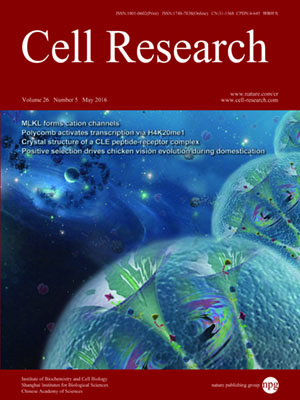
Volume 26, No 5, May 2016
ISSN: 1001-0602
EISSN: 1748-7838 2018
impact factor 17.848*
(Clarivate Analytics, 2019)
Volume 26 Issue 5, May 2016: 517-528 | Open Access
ORIGINAL ARTICLES
MLKL forms cation channels
Bingqing Xia1, Sui Fang1, Xueqin Chen1, Hong Hu2, Peiyuan Chen1, Huayi Wang2 and Zhaobing Gao1
1CAS Key Laboratory of Receptor Research, Shanghai Institute of MateriaMedica, Chinese Academy of Sciences, 555 Zuchongzhi Road, Shanghai 201203, China
2School of Life Science and Technology, Shanghai Tech University Shanghai 200031, China
Correspondence: Huayi Wang, E-mail: wanghuayi@shanghaitech.edu.cn; Zhaobing Gao,(zbgao@simm.ac.cn)
The mixed lineage kinase domain-like (MLKL) protein is a key factor in tumor necrosis factor-induced necroptosis. Recent studies on necroptosis execution revealed a commitment role of MLKL in membrane disruption. However, our knowledge of how MLKL functions on membrane remains very limited. Here we demonstrate that MLKL forms cation channels that are permeable preferentially to Mg2+ rather than Ca2+ in the presence of Na+ and K+. Moreover, the N-terminal domain containing six helices (H1-H6) is sufficient to form channels. Using the substituted cysteine accessibility method, we further determine that helix H1, H2, H3, H5 and H6 are transmembrane segments, while H4 is located in the cytoplasm. Finally, MLKL-induced membrane depolarization and cell death exhibit a positive correlation to its channel activity. The Mg2+-preferred permeability and five transmembrane segment topology distinguish MLKL from previously identified Mg2+-permeable channels and thus establish MLKL as a novel class of cation channels.
10.1038/cr.2016.26
FULL TEXT | PDF
Browse 2302


